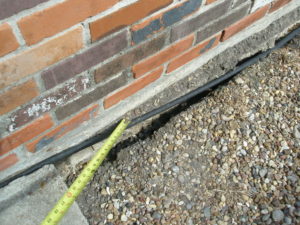Foundation Maintenance & Drainage

In the areas where expansive soils are present, positive drainage should be provided away from the foundations. Changes in moisture content of expansive soils are the cause of both swelling and shrinking. Positive drainage should also be maintained in the areas where sandy soils are present.
Positive drainage is extremely important in minimizing soil-related foundation problems. When homeowners berm the flowerbed areas, they create a dam between the berm and the foundation, preventing the surface water from draining away from the structure. This condition may be visually appealing but can cause significant foundation damage as a result of negative drainage.
The most commonly used technique for grading is a positive drainage away from the structure to promote rapid runoff and to avoid collecting ponded water near the structure which could migrate down the soil/foundation interface. The slope should be about 3 to 5 percent within 10 feet of the foundation.
Should the owner change the drainage pattern, he should develop positive drainage by backfilling near the grade beams with select fill compacted to 90 percent of the maximum dry density as determined by ASTM D 698-91 (standard proctor).
This level of compaction is required to minimize subgrade settlements near the foundations and subsequent ponding of the surface water. The select fill soils should consist of silty clays and sandy clays with liquid limits less than 40 and plasticity index (PI) between 10 and 20. Bank sand or topsoils are not a select fill. The use of bank sand or topsoils to improve drainage away from a house is discouraged; because sands are very permeable. In the event that sands are used to improve drainage away from the structure, one should make sure the clay soils below the sands have a positive slope (3-5 percent) away from the structure since the clay soils control the drainage away from the house.
Depressions or water catch basin areas should be filled with compacted soil (sandy clays or silty clays, not bank sand) to have a positive slope from the structure, or drains should be provided to promote runoff from the water catch basin areas. Six to twelve inches of compacted, impervious, nonswelling soil, placed on the site prior to construction of the foundation, can improve the necessary grade and contribute additional uniform surcharge pressure to reduce uneven swelling of underlying expansive soil.
Foundation & Drainage Continued
 Pets (dogs, etc.) sometimes excavate next to the exterior grade beams and create depressions and low spots in order to stay cool during the hot season. This condition will result in ponding of the surface water in the excavations next to the foundation and subsequent foundation movements. These movements can be in the form of uplift in the area with expansive soils and settlement in the areas with sandy soils. It is recommended as a part of the foundation maintenance program that the owner backfills all excavations created by pets next to the foundation with compacted clay fill.
Pets (dogs, etc.) sometimes excavate next to the exterior grade beams and create depressions and low spots in order to stay cool during the hot season. This condition will result in ponding of the surface water in the excavations next to the foundation and subsequent foundation movements. These movements can be in the form of uplift in the area with expansive soils and settlement in the areas with sandy soils. It is recommended as a part of the foundation maintenance program that the owner backfills all excavations created by pets next to the foundation with compacted clay fill.
Grading and drainage should be provided for structures constructed on slopes, particularly for slopes greater than 9 percent, to rapidly drain off water from the cut areas and to avoid ponding of water in cuts or on the uphill side of the structure. This drainage will also minimize seepage through backfills into adjacent basement walls.
Subsurface drains may be used to control a rising water table, groundwater, and underground streams, and surface water penetrating through previous or fissured and highly permeable soil. Drains can help control the water table in the expansive soils. Furthermore, since drains cannot stop the migration of moisture through the expansive soil beneath foundations, they will not prevent long-term swelling. Moisture barriers can be placed near the foundations to minimize moisture migration under the foundations. The moisture barriers should be at least five-feet deep in order to be effective.
Area drains can be used around the house to minimize ponding of the surface water next to the foundations. The area drains should be checked periodically to assure that they are not clogged. The drains should be provided with outlets or sumps to collect water and pumps to expel water if gravity drainage away from the foundation is not feasible. Sumps should be located well away from the structure. Drainage should be adequate to prevent any water from remaining. In the drain (i.e. a slope of at least 1/8 inch per foot of drain or 1 percent should be provided).
Positive drainage should be established underneath structural slabs with crawl space. This area should also be properly vented. The absence of positive drainage may result in surface water ponding and moisture migration through the slab. This may result in wood floor warping and tile unsticking.
Schedule Your Evaluation Today
Foundations & Drainage Conclusion
 It is recommended that at least six-inches of clearing be developed between the grade and the wall siding. This will minimize surface water entry between the foundation and the wall material in turn minimizing wood decay.
It is recommended that at least six-inches of clearing be developed between the grade and the wall siding. This will minimize surface water entry between the foundation and the wall material in turn minimizing wood decay.
Poor drainage at residential projects in North and West Houston can result in saturation of the surficial sands and development of a perched water table. The sands, once saturated, can lose their load carrying capacity. This can result in foundation settlements and bearing capacity failures. Foundation in these areas should be designed assuming saturated subsoil conditions.
In general, roof drainage systems, such as gutters or rain dispenser devices are recommended all around the roof line with gutters and downspouts kept unobstructed by leaves and tree limbs. In areas where expansive soils are present, the gutters should be connected to flexible pipe extensions so that the roof water is drained at least 10-feet away from the foundations. Preferably the pipes should direct the water when sandy soils are present, at least five-feet away from the foundations.
If a roof drainage system is not installed, rain water will drip over the eaves and fall next to the foundations resulting in subgrade soil erosion, and creating a depression in the soil mass, which may allow the water to seep directly under the foundation and floor slabs.
The homeowner must pay special attention to leaky pools and plumbing. In the event that the water bill goes up suddenly, without any apparent reason, the owner should check for a plumbing leak.
The introduction of water to expansive soils can cause significant subsoil movements. The introduction of water to sandy soils can result in a reduction in soil bearing capacity and subsequent settlement. The homeowner should also be aware of water coming from the air conditioning drain lines. The amount of water from the condensing air conditioning drain lines can be significant and can result in localized foundation distress.
As the air conditioner runs, it pulls a significant amount of water out of the air and the water normally is sent into the home’s plumbing system drain lines. If those drain lines are not properly working and the water is sent to the outside of the home via the secondary drain lines, (commonly placed over a window in the soffit) where this extra water is introduced to the surrounding soil, this could adversely affect the foundation.
Similarly, if either a fresh water plumbing line or a waste water drain line has a leak in them under the house or in close proximity to the foundation, structural issues could become significant.

